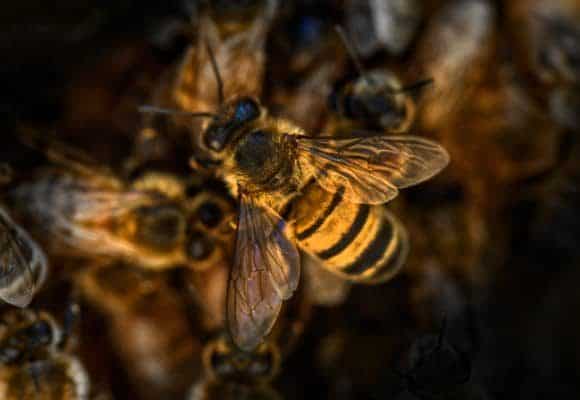
Bees are known for producing great tasting honey and having an all important queen bee. The little insects fly around, pollinating flowers and working hard in their nest or hive. However, with over 16,000 different species of bees, there are differences in lifestyle. One of the distinct contrasts is that some bees live in colonies and others live a solitary life.
With that in mind, do all bees live in colonies? Many species of bees do not live in colonies. While the most well-known bees, the honey bee, and the bumblebee, live in colonies, many and possibly the majority of bees do not live in colonies. These bees otherwise known as solitary bees are more likely to live by themselves.
All bees fly around, collecting pollen and using it as a source of nutrients. But, with a widely diverse range of bee species, there are bound to be multiple differences between all of them. The remainder of this article will unpack more about these pollination superstars and the differences between colony bees and solitary bees.
About Bees & Colonies
Stereotypically bees are known as little black and yellow insects that buzz around flowers and produce honey. While all bees collect pollen from plants, not all bees produce honey. All bees start as eggs that after an incubation period, hatch into larvae. From here they undergo multiple phases of change which result in the emergence of an adult bee.
For most people when we think of bees we think of honey bees living in hives making honey. It would be natural to assume that all bees live in colonies in this way. In actual fact, many species of bees don’t live in colonies at all…
The scientific term for bees that live in colonies is “eusocial bees”. They are classified this way because they demonstrate a high level of social organization with a single female that produces offspring that are non-reproductive individuals that work together to care for the young.
Eusocial bees’ system of reproduction is called haplodiploidy. The haplodiploid system is where males of a species are made from a haploid, or unfertilized, egg and the female is made from a diploid, or fertilized, egg.
This means that the offspring of the father share one hundred percent of the father’s genes while sharing only sixty percent of the mother’s genes. Sisters also share seventy-five percent of genes.
For bees in colonies, the haplodiploid system, in theory, makes these bees more resilient as a species. This basically means they will be able to better preserve the future of their species by taking care of and protecting the queen bee. The queen after her mating flight will not leave the hive again unless the hive is swarming.
Having said that there many bee species that don’t live in colonies and live a more solitary existence. Below are the differences between eusocial bees, colonizing bees, and solitary bees.
Eusocial Bees
Eusocial bees live in colonies that consist of at least one queen bee and many worker bees. It is this advanced social structure that often has honey bees labeled as superorganisms.
Characteristics of Eusocial bees
Eusocial bees demonstrate three distinct characteristics:
- Brood Care
- Division of Labor
- Generational Living
1. Brood Care
In a colony, all members of the colony work together to take care of the offspring in the colony, even though the offspring are not their own. In a hive or colony, all the brood is from the queen bee. The worker bees often referred to as nurse bees take care of the brood, making sure the larvae are fed and that the brood temperature is regulated.
2. Division of Labor
The labor within the colony is divided into reproducing and non-reproducing groups. The queen bee is the only member of the group that is reproducing.
For the queen bee, her role is to lay eggs. She is the mother of all the bees in the hive. She has the ability to lay fertilized eggs for worker bees and unfertilized eggs for drones.
She uses pheromones to maintain communication with the worker bees. We have a really interesting article that dives into how bees communicate.
The drone bees (Male Bees) and the worker bees make up the non-reproductive group. The drone bees’ role is to mate with a queen, although it isn’t the queen from their own hive. They head out each day in an effort to mate with a virgin queen from another hive or colony.
The worker bees, as the name suggests, do the hard yards in the hive or colony. They care for the needs of the queen, feeding and cleaning her. The worker bees are also responsible for hive cleaning, hive construction, brood care, hive temperature regulation and ventilation, hive defense, and of course foraging for nectar and pollen.
How honey bees reproduce and their roles in a hive is really very fascinating. If you are interested in knowing more about this, we have an article about how bees reproduce that goes into much more detail about this.
3. Generational Living
With honey bees, the queen can live up to 5 years, other species of bees like bumblebees the queen lives for about a year. In both instances, the queen will live through generations of worker bees. Worker bees, in turn, are overlapping generationally.
Nest Structure
The nest structures of eusocial colony bees differ from species to species in complexity and duration of use. Bumblebee nests tend to be more simple and last shorter periods. In the vast majority of colony bees, the nest is made up of comb-like structures that enable the worker bees to move about the hive structure.
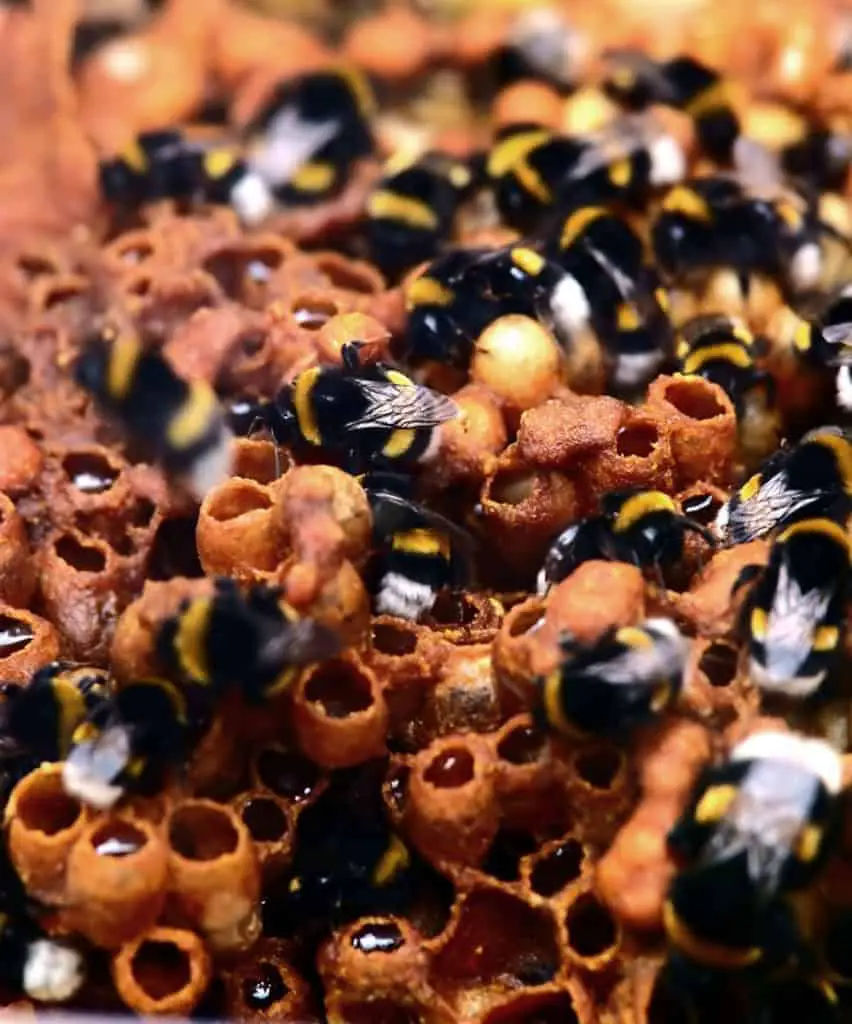
Honey bees have an advanced hive structure. They are well organized with a tight brood nest and stores of pollen and honey close by for efficient feeding of the larvae. The bees are able to reuse the combs repeatedly for generations of the brood. The combs of the honey bee can be reused for years as opposed to bumblebees that only use the nest structure for a single season.
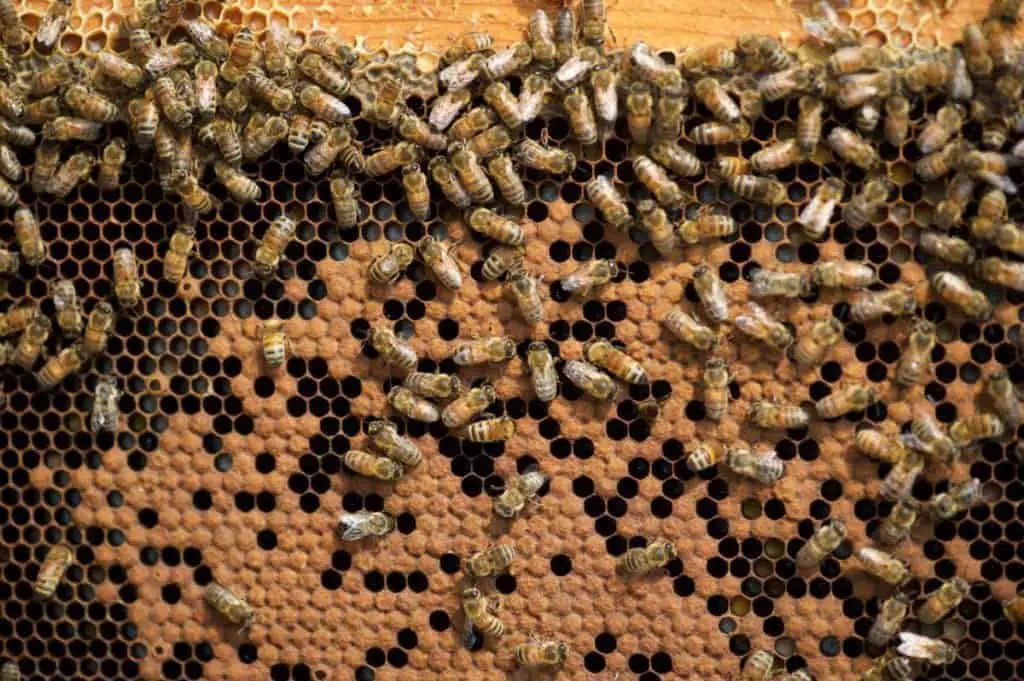
Caste System
The division of labor within the colony creates castes amongst the colony members. The way the castes are formed indicated different levels of eusociality. For example, a colony that consists of sister bees with one sister being the queen bee and the other sisters being worker bees is considered semi-social. A colony that consists of a mother as queen bee and her daughters as the worker bees are considered eusocial.
Roles in the Caste System
In the caste system, there are two primary roles for females, either as the queen bee or the worker bee. The male’s sole purpose is to mate with the queen bee.
- Queen Bee: A queen bee in a colony is responsible for reproducing and populating the colony. A queen bee is created with the use of royal jelly, a jelly that promotes the formation of a queen bee when used in copious amounts. This jelly promotes the development of the queen’s ovaries and allows her to reproduce. Queen bees tend to live longer than worker bees.
- Worker Bees: Worker bees are tasked with building the nests and structures necessary to keep the colony going. In many colonies, the worker bees also protect the colony from attacks and are sterile. Worker bees tend to have shorter lives
Below we have a flowchart the demonstrates the caste system that honey bees operate under. It also highlights the division of labor within the hive.
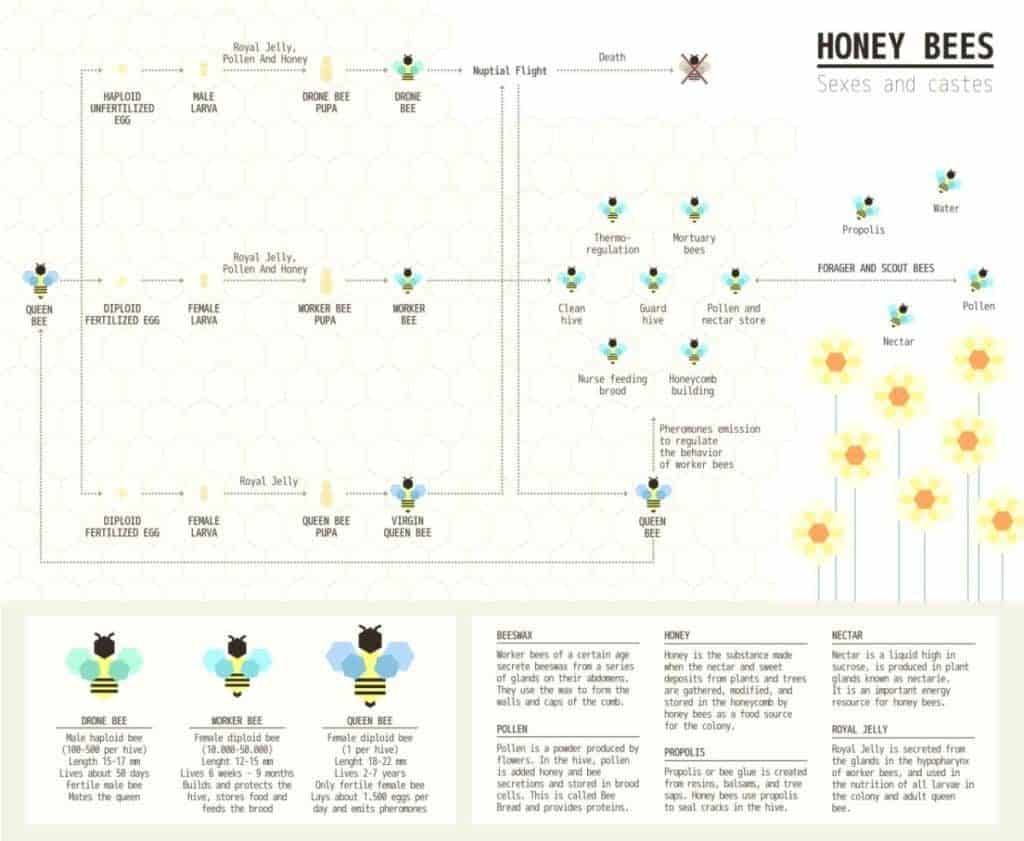
Food System
In colonies, the offspring are fed by progressive provisioning; this means that the offspring are fed as they grow, which requires more work as they are being raised. This also requires the nest system to be more complex to allow for more movement in and out of the various places in the nest.
Different Types of Colonies
Not all colonies are the same. Some, like honey bees, consist of thousands of bees while other colonies like bumblebees may have as few as 50 worker bees.
Some colonies like those of bumblebees are seasonal and will die out in the winter. Honey bees on the other hand if left untendered by a beekeeper will build up their numbers and create a second queen before swarming.
When the hive swarms one of the queens will take a large number of worker bees and leave the hive in search of another location for a new hive.
Solitary Bees
The majority of solitary bees live by themselves and therefore have to do all the work to guarantee the survival of their species. They also have many differences from colony bees:
- No Honey
- No Division of Labor
- Simple Nests
- Lifespan
- Stingers
- Solitary Socializing
- “Communal” Living
1. No Honey
No solitary bees produce or store honey. Solitary bees consume nectar from flowers for energy. They collect pollen and mix it with nectar to feed their young. They are typically very good pollinators. According to Grow Wild, a single red mason bee is the equivalent to 120 honey bees when it comes to pollination.
2. No Division of Labor
Because solitary bees live alone, there is no division of labor. Solitary bees scavenge for food and build the nest by themselves.
3. Simple Nests
Solitary bees have much simpler nests than colony bees. The nests don’t use the comb structures and are typically found in holes in the ground or holes in a tree. Some species like carpenter bees can be quite destructive boring holes in the patio or deck of your house. Solitary bee nests are also much smaller since they typically only consist of a single bee.
The bee lays eggs and seals them in “cells” with provisions. The cells are basically a room for the egg and provisions. Solitary bees do not raise the brood of offspring. The smaller nests also allow the bees to protect the nest by themselves.
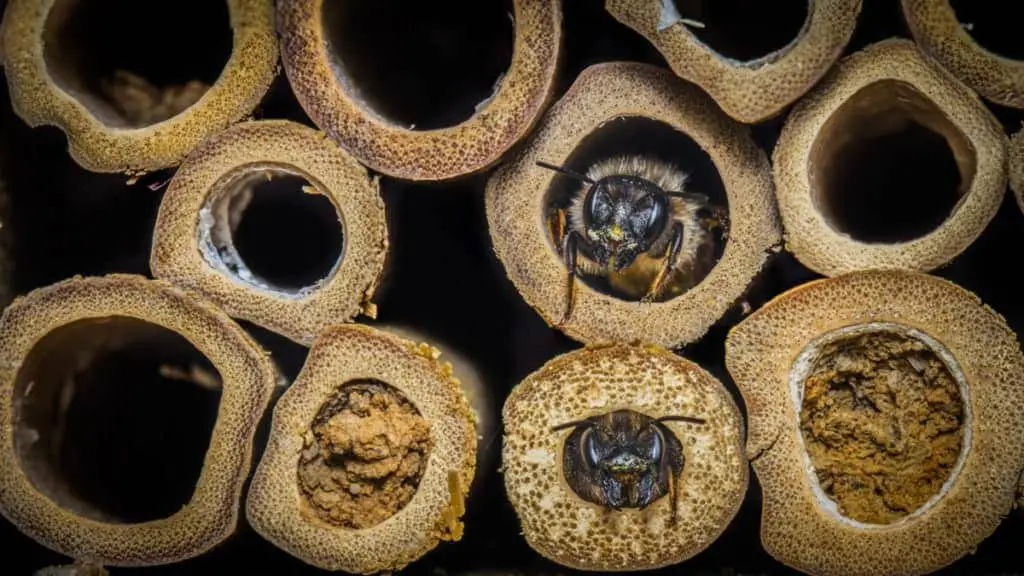
4. Lifespan
Solitary bees tend to live short lives. The bees can make one or two nests filled with their offspring before they die.
5. Stingers
Solitary bees, for the most part, do not have stingers. If they do have stingers, solitary bees are typically not aggressive and won’t sting you unless they feel threatened and sting in self-defense.
6. Solitary Socializing
Having their own homes does not mean that solitary bees don’t socialize. Many solitary bees like to be gregarious. This means the bees like to build their nests next to other bees of the same species. Large groups of these nests next to each other are called aggregations.
7. “Communal” Living
While solitary bees believe in being independent, some bees will share a nest with other female bees. These do not rise to the level of a colony. The bees still do all their work by themselves and make the cell-like rooms for their future offspring alone.
The Wrap Up
Bees are insects that contribute greatly to our society. Some help pollinate flowers while others produce delicious honey. While some bees perform these functions while in a colony, others can pollinate while living by themselves.
One thing is for sure whether they are solitary bees or colony bees, we need to look after our bees. The world literally depends on them.
References:
https://en.wikipedia.org/wiki/Bee
https://en.wikipedia.org/wiki/Eusociality
https://en.wikipedia.org/wiki/Haplodiploidy
https://bees.techno-science.ca/english/bees/life-in-a-hive/worker-bee.php
https://www.perfectbee.com/learn-about-bees/the-life-of-bees/the-role-of-the-worker-bee
https://edis.ifas.ufl.edu/in1102
